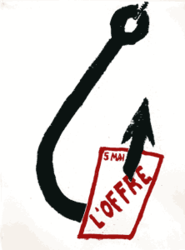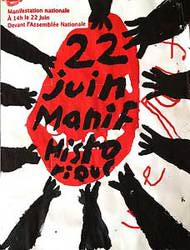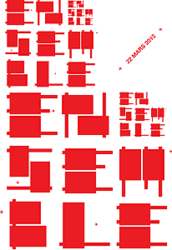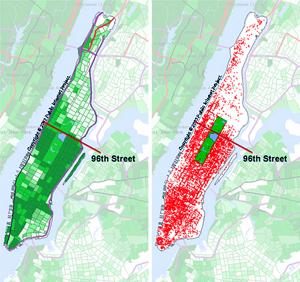canada
Les Casseroles
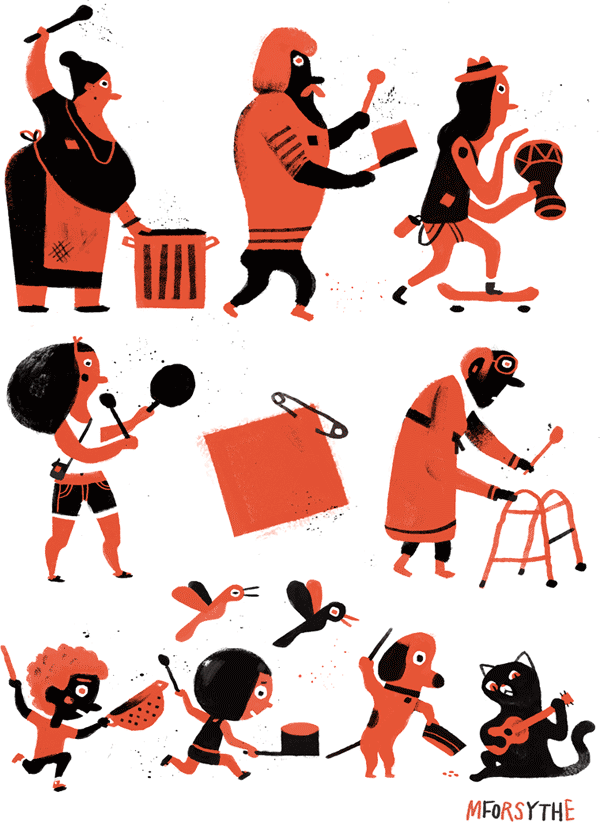
I love this image by illustrator Matt Forsythe. It nicely captures the spirit of the protests in Montréal last May. As The Globe and Mail notes:
“Those clanging pots, known as les casseroles, were initially seen as just another tactic, but a remarkable thing happened: Ordinary citizens armed only with kitchenware took back their streets from rock-throwers and riot police. They also pushed student and government leaders back to the negotiating table with fresh hope the conflict might end.”
You can download a high resolution version of the image from Matt’s website.
Here’s a nice video of les casseroles in action.
Protest Posters in Québec
Design students at the University of Québec started the École de la Montagne Rouge to produce visual materials supporting the 2012 student protests across Québec.
They’ve posted a lovely collection of poster designs, many in the spirit of Grapus and the Atélier Populaire. Here are some of my favorites below, linking to the larger versions.
The red square is the symbol of the Maple Spring and via Just Seeds I found Seeing Red Montréal, an ongoing documentation of red squares painted, stickered, and postered on the streets of Montreal.
Design Cares
DesignCares.com is a site collecting current examples of graphic projects in the public interest. Some nice elegant work, thus far mostly from Canada and mostly printed matter for non-profits and “children’s charities,” along with an occasional “random act of graphic vigilantism.”
From the site:
“We are collecting professional acts of social responsibility, as an inspiration for those looking for ideas, and as a celebration of the role designers are taking in helping repair the world....
Inspired by the Design Cares Web site, in 2001 the GDC Vancouver Island Chapter created the Design Cares Exhibit and Forum (with the generous support of Sappi Fine Papers, Adobe Systems, and others), and has published a travelling poster exhibit from the juried show. The Design Cares travelling exhibit is a celebration of the role designers are taking in helping to improve the world and shows the breadth and depth of how they use their creative skill to improve the human condition, save the environment or assist with a myriad charitable causes. The show has travelled internationally, including Slovenia, Qatar, Hungary, and Bahrain.”
DesignCares was started by members of the Society of Graphic Designers of Canada, a non-profit professional trade assocation:
The Society of Graphic Designers of Canada (GDC), a non-profit organization of design practitioners and educators. The GDC is concerned with standards of professional conduct, practice and integrity; education and professional development; and information about the profession. The organization was founded to promote and develop a defined, recognized and competent body of graphic designers and to encourage high standards of graphic design for the benefit of Canadian industry, commerce and community. The national goals of the Society include a commitment to improving the human environment by improving the quality of life and fostering public awareness of design expertise. Members share a code of ethics stating that we must take a responsible role in the visual portrayal of people, the consumption of natural resources, and the protection of animals and the environment.
Canada Out of Haiti!
Reader dru writes in about this graphic campaign around the upcoming elections in Canada:
“In February 2004, Canada backed a coup that removed Haiti’s democratically elected president (Aristide) and the entire elected government. Since then, they’ve been training police that have been shooting demonstrators, and propping up a ‘justice’ system that is systematically jailing political dissidents (the ones that aren’t in hiding or dead).
A bunch of Haiti solidarity activists are trying to unseat the Foreign Minister, Pierre Pettigrew (who had a brief cameo in The Corporation as a corrupt international trade minister), who played a key role (and continues to) in backing the post-coup government.
In the last election, he won by a very small margin in his riding of Papineau in north Montreal, which has a high population of Haitians.
In conjunction with groups in the Haitian community there, we're waging an all-out propaganda battle to unseat Pettigrew. Thousands of these posters: http://outofhaiti.ca/pettigrew/
Similar flyers have been distributed in the riding, and we hope to get a few thousand more out before election day (Jan. 23). Because the riding is such a hotspot, our posters have appeared on two nationally-broadcast TV news shows (in French and English).
Posters have also been created for the Prime Minister and his special advisor on Haiti and are going up in cities all across Canada.”
Read more about the campaign at http://outofhaiti.ca/
Post These Bills
Christopher DeWolf has a nice little editorial on posters and the political struggles around them in a couple of Canadian cities:
“Posters are the city. For community groups, musicians, activists, small businesses, and hell, even people who’ve lost their cat, they’re often the only way to get a message out. They cover lampposts, service doors, construction hoardings and blank walls, livening up grey and depressing winters and turning underused spaces into interactive bulletin boards where the city’s goings-on are announced to anyone who might be interested. Despite their importance to civic and cultural life however, posters are an all-too-easy target for municipal politicians and bureaucrats who want their city streets as bland and orderly as a Lego metropolis. Posters might seem innocuous, but they are in fact a sign of a city’s vitality and diversity — how municipalities deal with postering is a measure of just how willing they are to accommodate that vibrancy.”
DeWolf privileges “freedom of expression” and a “diversity” of voices but I would take it further and say that this is a matter of democracy itself — of ownership of the means of communication and the of the physical space of our communities, of building community and political power.
Repurposing Payphones
The Washington Post reports on the demise of the payphone:
“In Washington, as in other parts of the country, pay phones are disappearing from the landscape. The number of them across the country has dwindled from a high of 2.7 million in the mid-1990s to about 1.9 million now, supplanted by the more personal wireless phones that fit in a pocket. The small companies that maintain them are pulling out of the business. Even at the higher price of 50 cents a call, many phones run at a deficit — it costs more to clean, maintain and service them — so people like [technician Andres] Castro are yanking them from their sockets, cutting the lines, and pulling them from shopping centers, gasoline stations, restaurants and street corners where they used to turn a booming profit.”
The Globe and Mail reports that instead of dismantling its pay phones, Bell Canada has started adding WiFi capabilities:
“Aimed at business customers, the service is free until late March and available at several sites in Montreal, Kingston, Ont., and Toronto. The project will also include service at Air Canada airport lounges in Calgary, Montreal, Toronto and elsewhere. The pilot project is intended to measure how customers use the service and how much to charge for it, although some observers wonder if service providers will be able to make much money from so-called wireless fidelity or wi-fi hot spots. For Bell’s hot-spot trial, it’s mostly setting up wi-fi nodes where it has payphones, effectively ‘reinventing’ the payphone business.”
In the United States, massive amounts of cash are being thrown at building a nationwide wireless infrastructure. Adding WiFi to payphones is picks up on an exisitng infrastructure. From Bell Canada’s press release:
“The plan calls for payphones in high traffic areas to be fitted with Wi-Fi technology; typical locations include airports, train stations, hotels, convention centers and corporate campuses.”
Adding WiFi to payphones would be a good way of brining WiFi to underserved neighborhoods — the same neighborhoods that rely on pay phones rather than cell phones.
From the Post again:
“It is much easier — and cheaper — to dial from a cell phone for customers who can afford one. However, pay phones are still profitable in the lowest-income areas of a city, said Terry Rainey, president of the American Public Communications Council Inc., an industry group representing independent pay phone operators around the country.
‘There are a great number of people in this country without a phone,’ Rainey said — 4 and 5 percent, which is more than the 1 or 2 percent of the U.S. population that lacks television sets.
‘Some lower-income areas rely on [pay phones] for regular communications, as well as, in some cases, emergency calls,’ said Mason Harris, president of Robin Technologies and of the Atlantic Payphone Association.”
Compare this map of median household income from the 1990 U.S. Census with this 2002 map of WiFi hotspots in Manhattan. From the Public Internet Project:
Click here for a larger version.
Update: On May 10, 2003, the New Jersey Star-Ledger reported that Verizon plans to put WiFi transmitters in pay phones across New York City. No mention of how much it will cost to use.
Also of note is this May 5 article from the International Herald Tribune which describes plans by the city of Paris to build a WiFi network along the subway system. Two or three antennas could be places outside each of Paris’s 372 Metro stations.
Happy Water Power?
Hydroelectricity without the human rights and environmental disasters of dams? Maybe...
“Tidal energy exploits the natural rise and fall of coastal tidal waters caused principally by the interaction of the gravitational fields of the Sun and the Moon. Some coastlines, particularly estuaries accentuate this effect creating tidal ranges of up to 11m.”
Active tidal generators exist in Hammerfest in Norway, Annapolis in Canada, in France in the estuary of La Rance near St. Malo, and Kislaya Guba on the White Sea in Russia. This article summarizes a U.S. effort.
...
“Professor Thorstein Sigfusson, of the University of Iceland, says [the thermo-electric effect] works by translating the difference between the temperature of hot and cold water into energy....
In between the hot and the cold side are crystals made of semi-conductors. As the heat is transferred through these crystals part of it is converted from heat energy into electric energy.
Professor Sigfusson said there was potential for using all sorts of excess heat to fuel Thermators.” (BBC)
...
Japanese researchers are working on an experiemental power plant that produces both power and clean drinking water. From the New York Times:
“The university is preparing to build an experimental power plant off the coast of Palau that brings up cold seawater from the depths of the sea to an evaporator chamber near the ocean surface.
As the water is heated by the surrounding warm surface water, it releases ammonia gas, which then drives the system’s power generator...
Meanwhile, the heated water would be transferred to a separate low-pressure chamber where it boils at a lower temperature, producing steam, which would be condensed and collected as fresh water for human consumption, leaving salt crystals behind...
‘It works well especially in the western Pacific, where the temperature difference between the ocean’s surface and deep seawater is’ as much as 43 degrees Fahrenheit, he said. ‘It is environmentally sound.’”
Light. Cheap.
Instigated by Dr. Dave Irvine-Halliday, professor of Electrical and Computer Engineering at the University of Calgary, Canada, the Light Up the World Foundation “introduces a safe, simple, healthy, reliable and affordable form of home lighting, using white light emitting diodes. This rugged home lighting system will allow people in some of the poorest and least developed rural communities to light up their homes and raise their quality of living.... The lights are powered by a relatively cheap, belt driven pedal system and rechargable battery. It takes less than half an hour to put enough charge into it to run a set of 8 WLEDs for an entire evening.”
Found via slashdot.


